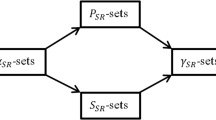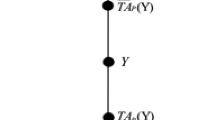Abstract
Molodtsov’s soft set theory is a newly emerging tool to deal with uncertain problems. Based on the novel granulation structures called soft approximation spaces, Feng et al. initiated soft rough approximations and soft rough sets. Feng’s soft rough sets can be seen as a generalized rough set model based on soft sets, which could provide better approximations than Pawlak’s rough sets in some cases. This paper is devoted to establishing the relationship among soft sets, soft rough sets and topologies. We introduce the concept of topological soft sets by combining soft sets with topologies and give their properties. New types of soft sets such as keeping intersection soft sets and keeping union soft sets are defined and supported by some illustrative examples. We describe the relationship between rough sets and soft rough sets. We obtain the structure of soft rough sets and the topological structure of soft sets, and reveal that every topological space on the initial universe is a soft approximating space.
Similar content being viewed by others
References
Aktas H N. Cağman, (2007) soft sets and soft groups. Inf Sci 177:2726–2735
Császár A (2002) Generalized topology, generalized continuity. Acta Mathematica Hungarica 96:351–357
Császár A (1997) Generalized open sets. Acta Mathematica Hungarica 75:65–87
Feng F, Li C, Davvaz B (2010) Soft sets combined with fuzzy sets and rough sets: a tentative approach. Soft Comput 14:899–911
Feng F, Liu X, Leoreanu-Fotea V, Jun Y (2011) Soft sets and soft rough sets. Inf Sci 181:1125–1137
Grzymala-Busse JW (2011) Mining incomplete data—a rough set approach, rough sets and knowledge technology. Lect Notes Comput Sci 6954:1–7
Ge X, Li Z, Ge Y (2011) Topological spaces and soft sets. J Comput Anal Appl 13:881–885
Jiang Y, Tang Y, Chen Q, Wang J, Tang S (2010) Extending soft sets with description logics. Comput Math Appl 59:2087–2096
Kong Z, Gao L, Wang L, Li S (2008) The normal parameter reduction of soft sets and its algorithm. Comput Math Appl 56:3029–3037
Maji PK, Biswas R, Roy AR (2003) Soft set theory. Comput Math Appl 45:555–562
Maji PK, Biswas R, Roy AR (2001) Fuzzy soft sets. J Fuzzy Math 9:589–602
Majumdar P, Samanta SK (2008) Similarity measure of soft sets. New Math Nat Comput 4(1):1–12
Maji PK, Roy AR, Biswas R (2002) An application of soft sets in a decision making problem. Comput Math Appl 44:1077–1083
Molodtsov D (1999) Soft set theory-first result. Comput Math Appl 37:19–31
Pawlak Z (1991) Rough sets: theoretical aspects of reasoning about data. Kluwer Academic Publishers, Boston
Pei D, Miao D (2005) From soft sets to information systems. In: Hu X, Liu Q, Skowron A, Lin TY, Yager RR, Zhang B (eds) Proceedings of Granular Computing, IEEE, vol 2, pp 617–621
Roy AR, Maji PK (2007) A fuzzy soft set theoretic approach to decision making problems. J Comput Appl Math 203:412–418
Shabir M, Naz M (2011) On soft topological spaces. Comput Math Appl 561:1786–1799
Skowron A, Stepaniuk J (1996) Tolerance approximation spaces. Fundamenta Informaticae 27:245–253
Slowinski R, Vanderpooten D (1995) Similarity relation as a basis for rough approximations. ICS Research Report 53:249–250
Slowinski R, Vanderpooten D (2000) A generalized definition of rough approximations based on similarity. IEEE Trans Data Knowl Eng 12(2):331–336
Yao YY (1996) Two views of the theory of rough sets in finite universes. Int J Approx Reason 15:291–317
Yao YY, Lin TY (1996) Generalization of rough sets using modal logics. Intell Autom Soft Comput 2(2):103–120
Zadeh LA (1965) Fuzzy sets. Inf Control 8:338–353
Author information
Authors and Affiliations
Corresponding author
Additional information
Communicated by L. G. Lacasa.
This work is supported by the National Natural Science Foundation of China (No. 11061004, 71140004), the Natural Science Foundation of Guangxi (No. 2013GXNSFBA019016) and Guangxi University Science and Technology Research Project (No. 2013ZD020, 2013ZD061).
Rights and permissions
About this article
Cite this article
Li, Z., Xie, T. The relationship among soft sets, soft rough sets and topologies. Soft Comput 18, 717–728 (2014). https://doi.org/10.1007/s00500-013-1108-5
Published:
Issue Date:
DOI: https://doi.org/10.1007/s00500-013-1108-5




